The Role of Social Entrepreneurship in Sustainable Development
VerifiedAdded on 2023/03/23
|8
|2377
|54
Essay
AI Summary
This essay examines social entrepreneurship as a powerful force for societal good, contrasting it with traditional profit-driven entrepreneurship. It highlights the focus on creating positive social impact and achieving cultural, social, and environmental goals. The essay discusses how social entrepreneurs identify and address societal issues through innovative strategies, often blurring the lines between public, private, and non-profit sectors. Key examples like Bill Drayton of Ashoka, Muhammed Yunus of Grameen Bank, and Jeffery Hollender of Seventh Generation are presented to illustrate the diverse approaches and significant impacts of social entrepreneurship. The essay also explores different models adopted by social enterprises, including innovation, employment, and give-back models, using organizations like Solar Sister, Faire Collection, and Roma Boots as examples. It further discusses the role of corporate social responsibility and the challenges faced by non-profit organizations, emphasizing the importance of financial stability and innovative approaches in addressing societal problems. The essay concludes by advocating for greater recognition and support for social entrepreneurship to maximize its potential for positive change.
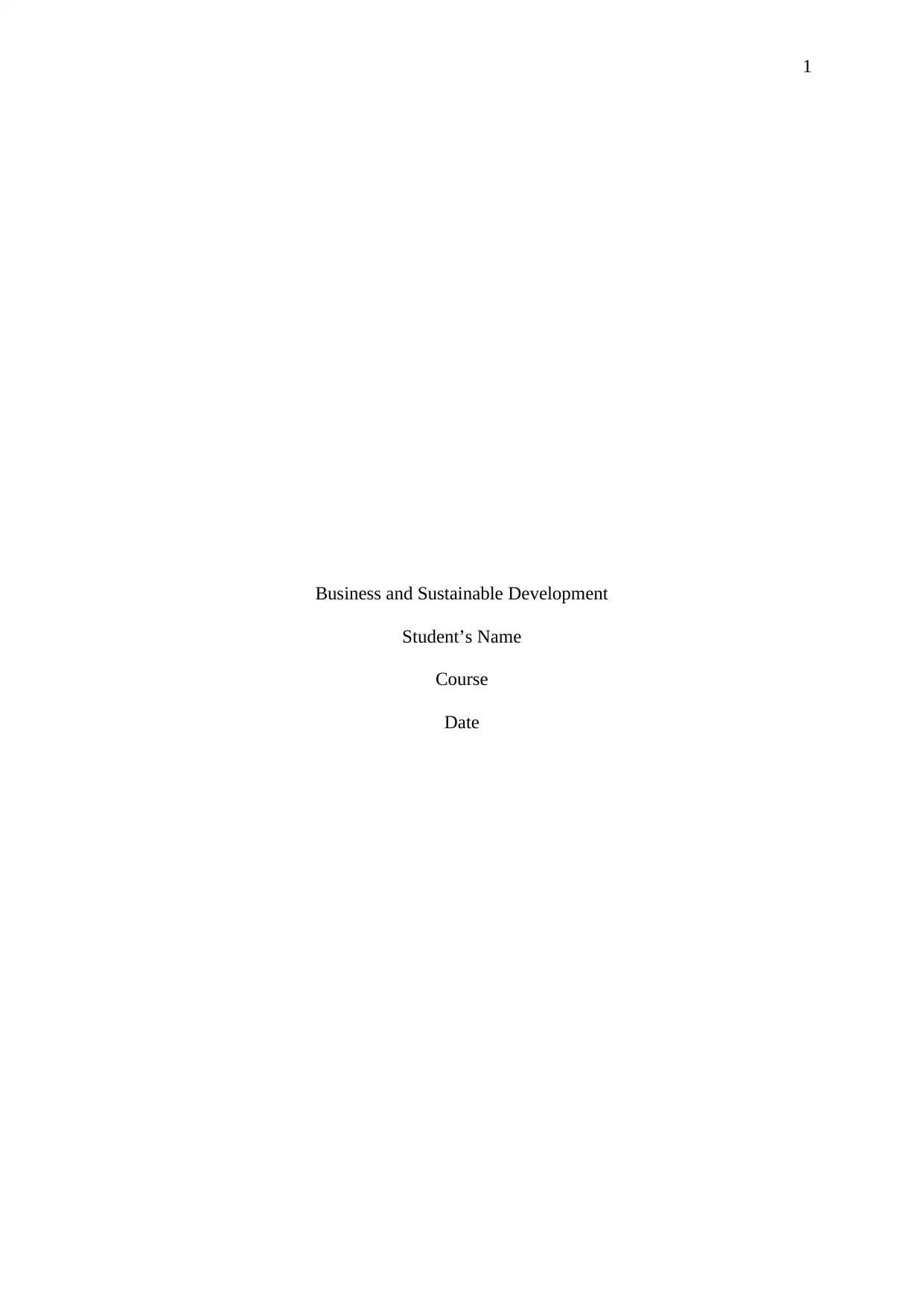
1
Business and Sustainable Development
Student’s Name
Course
Date
Business and Sustainable Development
Student’s Name
Course
Date
Paraphrase This Document
Need a fresh take? Get an instant paraphrase of this document with our AI Paraphraser

2
Business and Sustainable Development
Social entrepreneurship has become one of the primary concepts in the last few years
since many public sectors have adopted it, non-profit organisations as well as private sectors.
The primary focus of social entrepreneurship is on establishing benefits in the society through
the implementation of viable business strategies. On the other hand, Orthodox entrepreneurs
have an objective of maximising on profits to measure their success level while social
entrepreneurship does not only focus on profits but also adds value to the social performance
of a business. It aims to generate a constructive social impact as well as widen the cultural,
social along with conservational goals.
Social entrepreneurs identify and analyse all the societal issues and concerns which
helps them to gain and an understanding in a larger context. They have a sense of freedom
which allows them to navigate through all the problems hence finding innovative technics
along with solutions that can lead to change. Therefore, it entails taking risks, deviating
resources and finding innovative ways of creating social awareness of societal issues while
building strategies to find effective solutions. When a company has the right strategies, it can
benefit its brand image and society as well. Working toward benefiting society can change
the perception of the community towards the organisation. Concepts such as corporate social
responsibility, green market, and Fair trader are closely related to the idea of social
entrepreneurship. Even though the concepts focus on different sections of the business, they
provide society with the ability to tackle societal problems. In this essay, we will explore in
the manner in which the concepts mentioned earlier utilises business as a force of good to
work relatively close to societal entrepreneurship.
Social entrepreneurs have a hidden motive for dealing with complex societal
requirements. Therefore, they have to give prominence in solving societal issues as well as
needs by the use of innovative concepts. However, this tends to blur all the traditional lines
Business and Sustainable Development
Social entrepreneurship has become one of the primary concepts in the last few years
since many public sectors have adopted it, non-profit organisations as well as private sectors.
The primary focus of social entrepreneurship is on establishing benefits in the society through
the implementation of viable business strategies. On the other hand, Orthodox entrepreneurs
have an objective of maximising on profits to measure their success level while social
entrepreneurship does not only focus on profits but also adds value to the social performance
of a business. It aims to generate a constructive social impact as well as widen the cultural,
social along with conservational goals.
Social entrepreneurs identify and analyse all the societal issues and concerns which
helps them to gain and an understanding in a larger context. They have a sense of freedom
which allows them to navigate through all the problems hence finding innovative technics
along with solutions that can lead to change. Therefore, it entails taking risks, deviating
resources and finding innovative ways of creating social awareness of societal issues while
building strategies to find effective solutions. When a company has the right strategies, it can
benefit its brand image and society as well. Working toward benefiting society can change
the perception of the community towards the organisation. Concepts such as corporate social
responsibility, green market, and Fair trader are closely related to the idea of social
entrepreneurship. Even though the concepts focus on different sections of the business, they
provide society with the ability to tackle societal problems. In this essay, we will explore in
the manner in which the concepts mentioned earlier utilises business as a force of good to
work relatively close to societal entrepreneurship.
Social entrepreneurs have a hidden motive for dealing with complex societal
requirements. Therefore, they have to give prominence in solving societal issues as well as
needs by the use of innovative concepts. However, this tends to blur all the traditional lines

3
that exist between various public, private, and non-profit organisations and society. In fact,
social entrepreneurship stresses the use of various models that entail the use of innovative
strategies of non-profit and profit business activities. Thus, promoting practices the enhance
innovation while emphasising on the collaboration between sectors. Furthermore, these types
of entrepreneurs use major strategies that advocate for the implementation of radical
approaches to help in solving issues. Even though these practices are still young, several
examples have proven the effect of adopting as well as promoting social entrepreneurship.
The social entrepreneurs are using their business savvy and technical know-how to change
the world and make it better. Nonetheless, this requires the combination of a traditional
business model with a social mission which have aided in making significant changes around
the world.
Bill Drayton is among the first and most known a social entrepreneur helped in
defining as well as promoting the concept of social entrepreneurship. He is the founder and
the current chair of Ashoka. The company is based on Innovators for the Public. It is
dedicated to find and help all the social entrepreneurs in the universe. He spread his expertise
in other organisations. Ashoka Foundation, as of 2010, had managed to sponsor 2,145
individuals across 73 nations. Some of these entrepreneurs have developed leading social
businesses hence making a significant impact on the communities all over the globe.
Muhammed Yunus started Grameen Bank and used it to promote the idea of
microloans and microcredit. The concept was based on providing loans to indigent
Bangladeshi who could not qualify for traditional bank loans because they were too poor.
This is an example of an entrepreneur who took the role of leaders in the community thus
providing the society with a solution to their problem. The action was not intended to gain
profits but to help the community by giving the poor in the society the chance to develop
that exist between various public, private, and non-profit organisations and society. In fact,
social entrepreneurship stresses the use of various models that entail the use of innovative
strategies of non-profit and profit business activities. Thus, promoting practices the enhance
innovation while emphasising on the collaboration between sectors. Furthermore, these types
of entrepreneurs use major strategies that advocate for the implementation of radical
approaches to help in solving issues. Even though these practices are still young, several
examples have proven the effect of adopting as well as promoting social entrepreneurship.
The social entrepreneurs are using their business savvy and technical know-how to change
the world and make it better. Nonetheless, this requires the combination of a traditional
business model with a social mission which have aided in making significant changes around
the world.
Bill Drayton is among the first and most known a social entrepreneur helped in
defining as well as promoting the concept of social entrepreneurship. He is the founder and
the current chair of Ashoka. The company is based on Innovators for the Public. It is
dedicated to find and help all the social entrepreneurs in the universe. He spread his expertise
in other organisations. Ashoka Foundation, as of 2010, had managed to sponsor 2,145
individuals across 73 nations. Some of these entrepreneurs have developed leading social
businesses hence making a significant impact on the communities all over the globe.
Muhammed Yunus started Grameen Bank and used it to promote the idea of
microloans and microcredit. The concept was based on providing loans to indigent
Bangladeshi who could not qualify for traditional bank loans because they were too poor.
This is an example of an entrepreneur who took the role of leaders in the community thus
providing the society with a solution to their problem. The action was not intended to gain
profits but to help the community by giving the poor in the society the chance to develop
⊘ This is a preview!⊘
Do you want full access?
Subscribe today to unlock all pages.

Trusted by 1+ million students worldwide
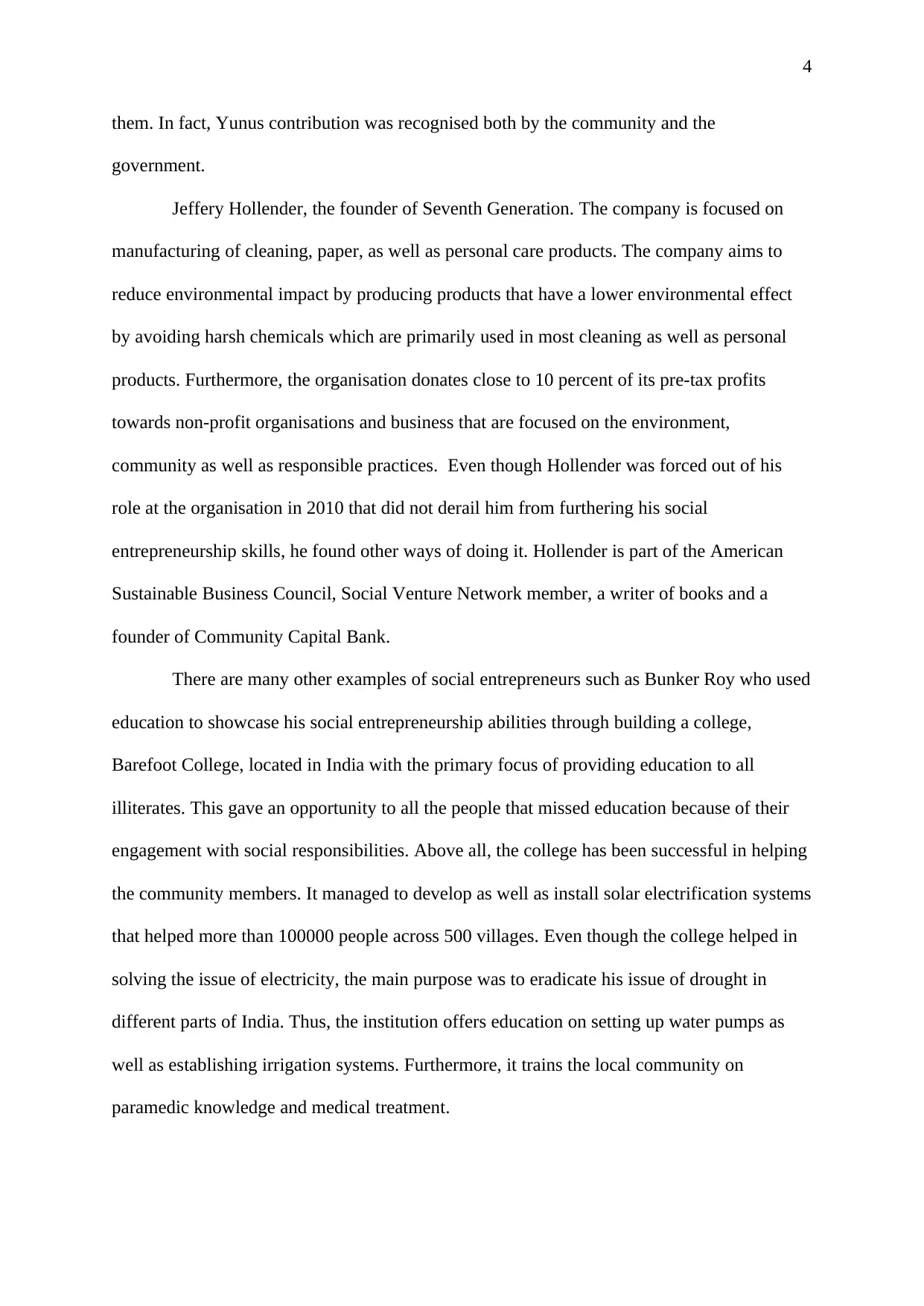
4
them. In fact, Yunus contribution was recognised both by the community and the
government.
Jeffery Hollender, the founder of Seventh Generation. The company is focused on
manufacturing of cleaning, paper, as well as personal care products. The company aims to
reduce environmental impact by producing products that have a lower environmental effect
by avoiding harsh chemicals which are primarily used in most cleaning as well as personal
products. Furthermore, the organisation donates close to 10 percent of its pre-tax profits
towards non-profit organisations and business that are focused on the environment,
community as well as responsible practices. Even though Hollender was forced out of his
role at the organisation in 2010 that did not derail him from furthering his social
entrepreneurship skills, he found other ways of doing it. Hollender is part of the American
Sustainable Business Council, Social Venture Network member, a writer of books and a
founder of Community Capital Bank.
There are many other examples of social entrepreneurs such as Bunker Roy who used
education to showcase his social entrepreneurship abilities through building a college,
Barefoot College, located in India with the primary focus of providing education to all
illiterates. This gave an opportunity to all the people that missed education because of their
engagement with social responsibilities. Above all, the college has been successful in helping
the community members. It managed to develop as well as install solar electrification systems
that helped more than 100000 people across 500 villages. Even though the college helped in
solving the issue of electricity, the main purpose was to eradicate his issue of drought in
different parts of India. Thus, the institution offers education on setting up water pumps as
well as establishing irrigation systems. Furthermore, it trains the local community on
paramedic knowledge and medical treatment.
them. In fact, Yunus contribution was recognised both by the community and the
government.
Jeffery Hollender, the founder of Seventh Generation. The company is focused on
manufacturing of cleaning, paper, as well as personal care products. The company aims to
reduce environmental impact by producing products that have a lower environmental effect
by avoiding harsh chemicals which are primarily used in most cleaning as well as personal
products. Furthermore, the organisation donates close to 10 percent of its pre-tax profits
towards non-profit organisations and business that are focused on the environment,
community as well as responsible practices. Even though Hollender was forced out of his
role at the organisation in 2010 that did not derail him from furthering his social
entrepreneurship skills, he found other ways of doing it. Hollender is part of the American
Sustainable Business Council, Social Venture Network member, a writer of books and a
founder of Community Capital Bank.
There are many other examples of social entrepreneurs such as Bunker Roy who used
education to showcase his social entrepreneurship abilities through building a college,
Barefoot College, located in India with the primary focus of providing education to all
illiterates. This gave an opportunity to all the people that missed education because of their
engagement with social responsibilities. Above all, the college has been successful in helping
the community members. It managed to develop as well as install solar electrification systems
that helped more than 100000 people across 500 villages. Even though the college helped in
solving the issue of electricity, the main purpose was to eradicate his issue of drought in
different parts of India. Thus, the institution offers education on setting up water pumps as
well as establishing irrigation systems. Furthermore, it trains the local community on
paramedic knowledge and medical treatment.
Paraphrase This Document
Need a fresh take? Get an instant paraphrase of this document with our AI Paraphraser
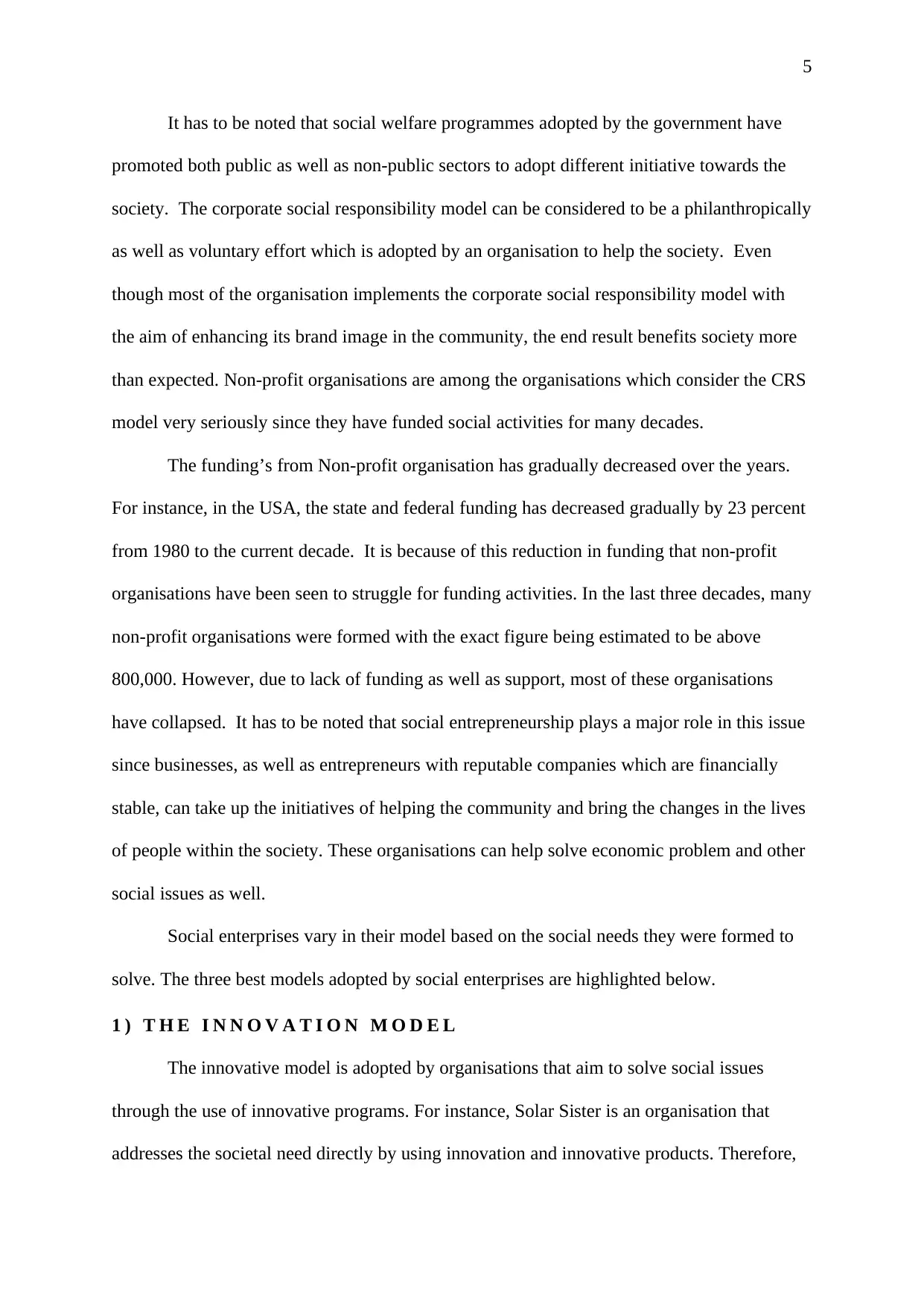
5
It has to be noted that social welfare programmes adopted by the government have
promoted both public as well as non-public sectors to adopt different initiative towards the
society. The corporate social responsibility model can be considered to be a philanthropically
as well as voluntary effort which is adopted by an organisation to help the society. Even
though most of the organisation implements the corporate social responsibility model with
the aim of enhancing its brand image in the community, the end result benefits society more
than expected. Non-profit organisations are among the organisations which consider the CRS
model very seriously since they have funded social activities for many decades.
The funding’s from Non-profit organisation has gradually decreased over the years.
For instance, in the USA, the state and federal funding has decreased gradually by 23 percent
from 1980 to the current decade. It is because of this reduction in funding that non-profit
organisations have been seen to struggle for funding activities. In the last three decades, many
non-profit organisations were formed with the exact figure being estimated to be above
800,000. However, due to lack of funding as well as support, most of these organisations
have collapsed. It has to be noted that social entrepreneurship plays a major role in this issue
since businesses, as well as entrepreneurs with reputable companies which are financially
stable, can take up the initiatives of helping the community and bring the changes in the lives
of people within the society. These organisations can help solve economic problem and other
social issues as well.
Social enterprises vary in their model based on the social needs they were formed to
solve. The three best models adopted by social enterprises are highlighted below.
1 ) T H E I N N O V A T I O N M O D E L
The innovative model is adopted by organisations that aim to solve social issues
through the use of innovative programs. For instance, Solar Sister is an organisation that
addresses the societal need directly by using innovation and innovative products. Therefore,
It has to be noted that social welfare programmes adopted by the government have
promoted both public as well as non-public sectors to adopt different initiative towards the
society. The corporate social responsibility model can be considered to be a philanthropically
as well as voluntary effort which is adopted by an organisation to help the society. Even
though most of the organisation implements the corporate social responsibility model with
the aim of enhancing its brand image in the community, the end result benefits society more
than expected. Non-profit organisations are among the organisations which consider the CRS
model very seriously since they have funded social activities for many decades.
The funding’s from Non-profit organisation has gradually decreased over the years.
For instance, in the USA, the state and federal funding has decreased gradually by 23 percent
from 1980 to the current decade. It is because of this reduction in funding that non-profit
organisations have been seen to struggle for funding activities. In the last three decades, many
non-profit organisations were formed with the exact figure being estimated to be above
800,000. However, due to lack of funding as well as support, most of these organisations
have collapsed. It has to be noted that social entrepreneurship plays a major role in this issue
since businesses, as well as entrepreneurs with reputable companies which are financially
stable, can take up the initiatives of helping the community and bring the changes in the lives
of people within the society. These organisations can help solve economic problem and other
social issues as well.
Social enterprises vary in their model based on the social needs they were formed to
solve. The three best models adopted by social enterprises are highlighted below.
1 ) T H E I N N O V A T I O N M O D E L
The innovative model is adopted by organisations that aim to solve social issues
through the use of innovative programs. For instance, Solar Sister is an organisation that
addresses the societal need directly by using innovation and innovative products. Therefore,
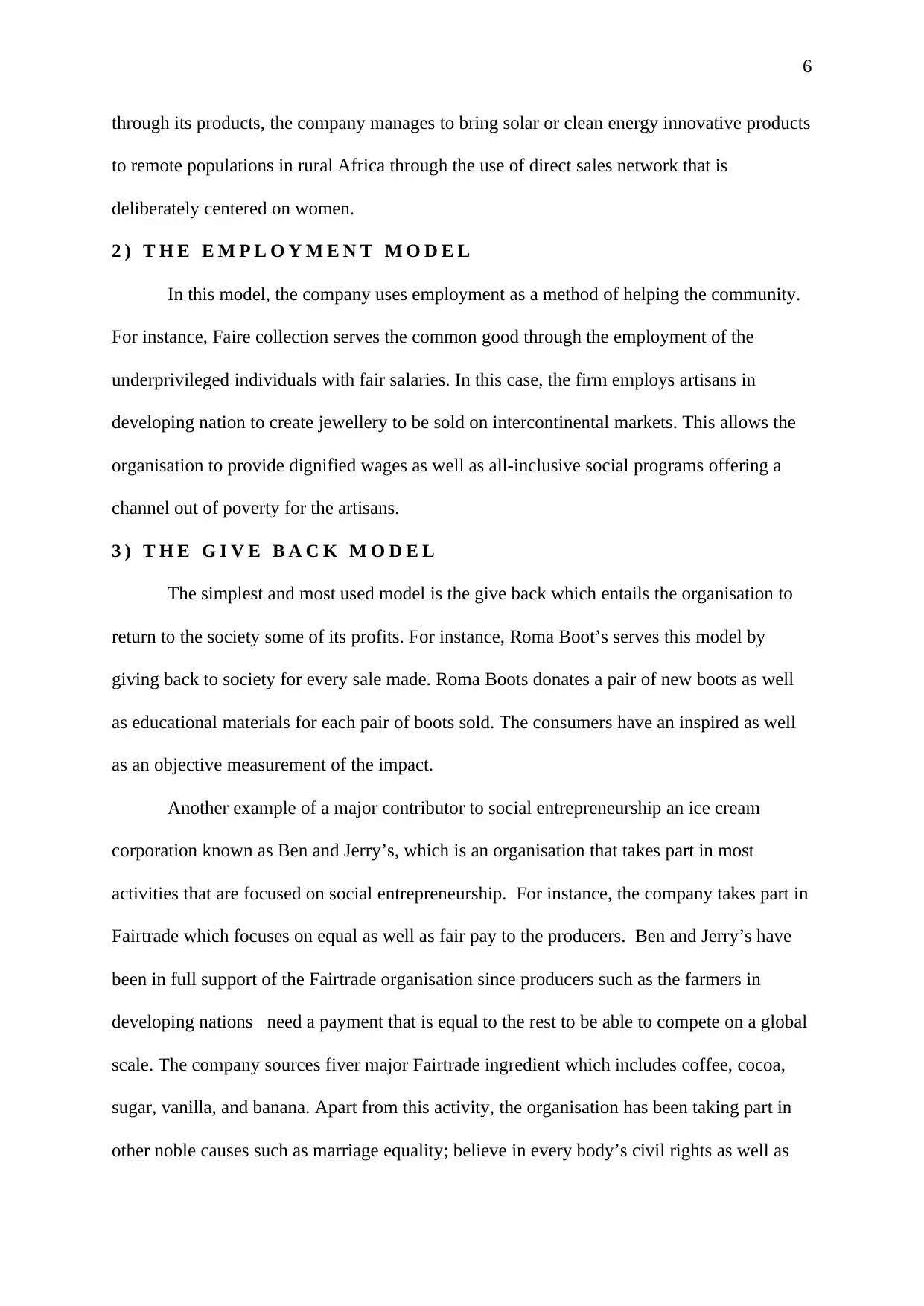
6
through its products, the company manages to bring solar or clean energy innovative products
to remote populations in rural Africa through the use of direct sales network that is
deliberately centered on women.
2 ) T H E E M P L O Y M E N T M O D E L
In this model, the company uses employment as a method of helping the community.
For instance, Faire collection serves the common good through the employment of the
underprivileged individuals with fair salaries. In this case, the firm employs artisans in
developing nation to create jewellery to be sold on intercontinental markets. This allows the
organisation to provide dignified wages as well as all-inclusive social programs offering a
channel out of poverty for the artisans.
3 ) T H E G I V E B A C K M O D E L
The simplest and most used model is the give back which entails the organisation to
return to the society some of its profits. For instance, Roma Boot’s serves this model by
giving back to society for every sale made. Roma Boots donates a pair of new boots as well
as educational materials for each pair of boots sold. The consumers have an inspired as well
as an objective measurement of the impact.
Another example of a major contributor to social entrepreneurship an ice cream
corporation known as Ben and Jerry’s, which is an organisation that takes part in most
activities that are focused on social entrepreneurship. For instance, the company takes part in
Fairtrade which focuses on equal as well as fair pay to the producers. Ben and Jerry’s have
been in full support of the Fairtrade organisation since producers such as the farmers in
developing nations need a payment that is equal to the rest to be able to compete on a global
scale. The company sources fiver major Fairtrade ingredient which includes coffee, cocoa,
sugar, vanilla, and banana. Apart from this activity, the organisation has been taking part in
other noble causes such as marriage equality; believe in every body’s civil rights as well as
through its products, the company manages to bring solar or clean energy innovative products
to remote populations in rural Africa through the use of direct sales network that is
deliberately centered on women.
2 ) T H E E M P L O Y M E N T M O D E L
In this model, the company uses employment as a method of helping the community.
For instance, Faire collection serves the common good through the employment of the
underprivileged individuals with fair salaries. In this case, the firm employs artisans in
developing nation to create jewellery to be sold on intercontinental markets. This allows the
organisation to provide dignified wages as well as all-inclusive social programs offering a
channel out of poverty for the artisans.
3 ) T H E G I V E B A C K M O D E L
The simplest and most used model is the give back which entails the organisation to
return to the society some of its profits. For instance, Roma Boot’s serves this model by
giving back to society for every sale made. Roma Boots donates a pair of new boots as well
as educational materials for each pair of boots sold. The consumers have an inspired as well
as an objective measurement of the impact.
Another example of a major contributor to social entrepreneurship an ice cream
corporation known as Ben and Jerry’s, which is an organisation that takes part in most
activities that are focused on social entrepreneurship. For instance, the company takes part in
Fairtrade which focuses on equal as well as fair pay to the producers. Ben and Jerry’s have
been in full support of the Fairtrade organisation since producers such as the farmers in
developing nations need a payment that is equal to the rest to be able to compete on a global
scale. The company sources fiver major Fairtrade ingredient which includes coffee, cocoa,
sugar, vanilla, and banana. Apart from this activity, the organisation has been taking part in
other noble causes such as marriage equality; believe in every body’s civil rights as well as
⊘ This is a preview!⊘
Do you want full access?
Subscribe today to unlock all pages.

Trusted by 1+ million students worldwide
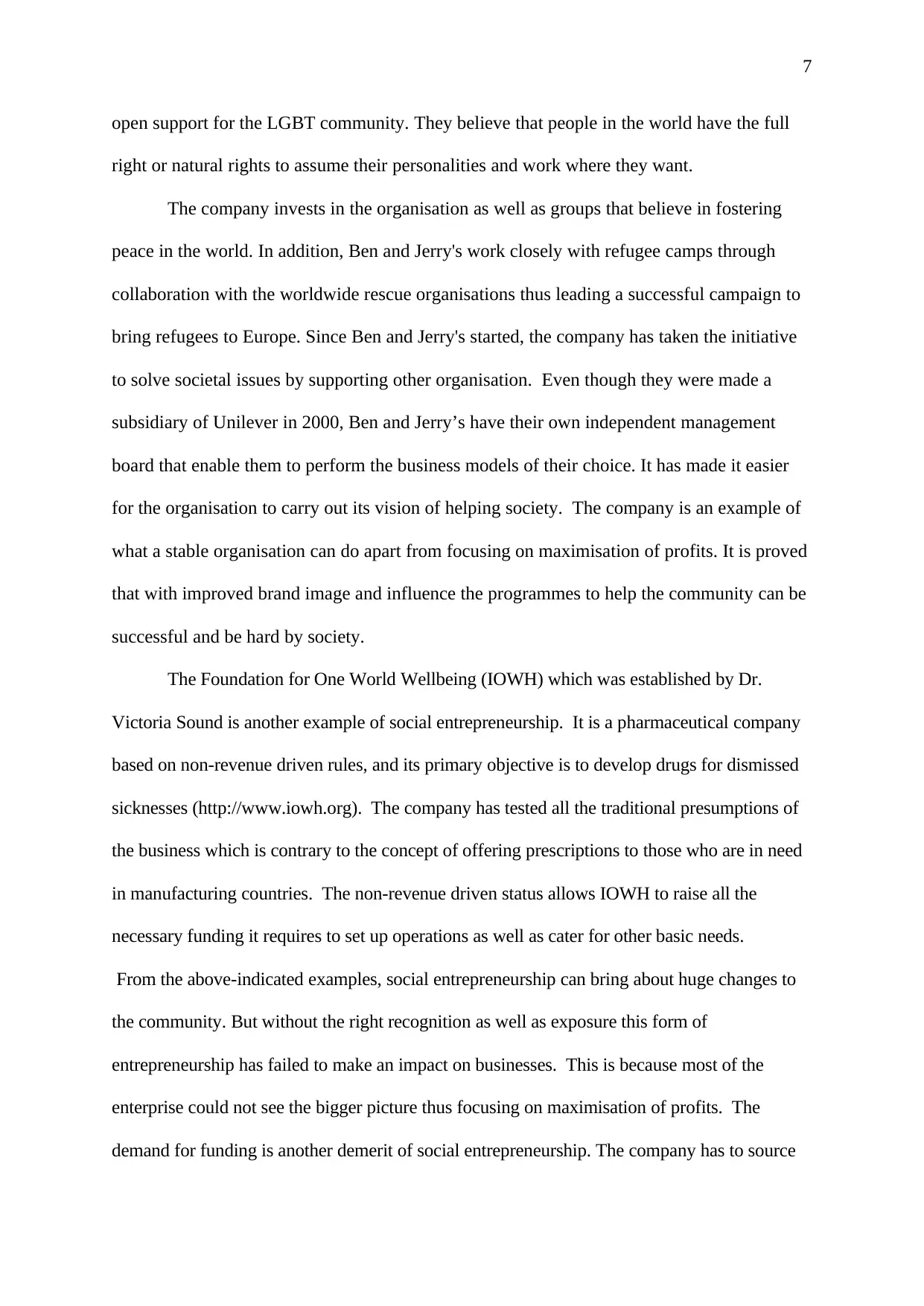
7
open support for the LGBT community. They believe that people in the world have the full
right or natural rights to assume their personalities and work where they want.
The company invests in the organisation as well as groups that believe in fostering
peace in the world. In addition, Ben and Jerry's work closely with refugee camps through
collaboration with the worldwide rescue organisations thus leading a successful campaign to
bring refugees to Europe. Since Ben and Jerry's started, the company has taken the initiative
to solve societal issues by supporting other organisation. Even though they were made a
subsidiary of Unilever in 2000, Ben and Jerry’s have their own independent management
board that enable them to perform the business models of their choice. It has made it easier
for the organisation to carry out its vision of helping society. The company is an example of
what a stable organisation can do apart from focusing on maximisation of profits. It is proved
that with improved brand image and influence the programmes to help the community can be
successful and be hard by society.
The Foundation for One World Wellbeing (IOWH) which was established by Dr.
Victoria Sound is another example of social entrepreneurship. It is a pharmaceutical company
based on non-revenue driven rules, and its primary objective is to develop drugs for dismissed
sicknesses (http://www.iowh.org). The company has tested all the traditional presumptions of
the business which is contrary to the concept of offering prescriptions to those who are in need
in manufacturing countries. The non-revenue driven status allows IOWH to raise all the
necessary funding it requires to set up operations as well as cater for other basic needs.
From the above-indicated examples, social entrepreneurship can bring about huge changes to
the community. But without the right recognition as well as exposure this form of
entrepreneurship has failed to make an impact on businesses. This is because most of the
enterprise could not see the bigger picture thus focusing on maximisation of profits. The
demand for funding is another demerit of social entrepreneurship. The company has to source
open support for the LGBT community. They believe that people in the world have the full
right or natural rights to assume their personalities and work where they want.
The company invests in the organisation as well as groups that believe in fostering
peace in the world. In addition, Ben and Jerry's work closely with refugee camps through
collaboration with the worldwide rescue organisations thus leading a successful campaign to
bring refugees to Europe. Since Ben and Jerry's started, the company has taken the initiative
to solve societal issues by supporting other organisation. Even though they were made a
subsidiary of Unilever in 2000, Ben and Jerry’s have their own independent management
board that enable them to perform the business models of their choice. It has made it easier
for the organisation to carry out its vision of helping society. The company is an example of
what a stable organisation can do apart from focusing on maximisation of profits. It is proved
that with improved brand image and influence the programmes to help the community can be
successful and be hard by society.
The Foundation for One World Wellbeing (IOWH) which was established by Dr.
Victoria Sound is another example of social entrepreneurship. It is a pharmaceutical company
based on non-revenue driven rules, and its primary objective is to develop drugs for dismissed
sicknesses (http://www.iowh.org). The company has tested all the traditional presumptions of
the business which is contrary to the concept of offering prescriptions to those who are in need
in manufacturing countries. The non-revenue driven status allows IOWH to raise all the
necessary funding it requires to set up operations as well as cater for other basic needs.
From the above-indicated examples, social entrepreneurship can bring about huge changes to
the community. But without the right recognition as well as exposure this form of
entrepreneurship has failed to make an impact on businesses. This is because most of the
enterprise could not see the bigger picture thus focusing on maximisation of profits. The
demand for funding is another demerit of social entrepreneurship. The company has to source
Paraphrase This Document
Need a fresh take? Get an instant paraphrase of this document with our AI Paraphraser

8
enough funds or be financially stable before coming up with innovative approaches that are
radical enough to solve the problems in society.
In conclusion, the essay has indicated that business enterprises can be used as a force
of good by social entrepreneurs. It does not matter the type of organisation, from non-profit
to profit organisation all business have the ability to offer to the society in one way or the. It
is the small contributions from these businesses that can make a major impact in the
community. From the examples adopted in the essay, we have seen the manner in which
social entrepreneurs have managed to create successful organisations. This organisation, in
turn, works towards developing new and innovative means of solving some societal issues
thus impacting a change in the society. The project implemented by social entrepreneurs has
been recognised by both the community and the government. Despite the fact that most
businesses focus on Fairtrade, corporate social responsibility and impact to the community as
a form of enhancing their brand image, it is relatively essential for the same effort to be
accorded to businesses that work towards societal benefits. This could be made easier by
offering support to these social entrepreneurs thus helping solve societal issues hence creating
a better future for everyone even those who are in need.
enough funds or be financially stable before coming up with innovative approaches that are
radical enough to solve the problems in society.
In conclusion, the essay has indicated that business enterprises can be used as a force
of good by social entrepreneurs. It does not matter the type of organisation, from non-profit
to profit organisation all business have the ability to offer to the society in one way or the. It
is the small contributions from these businesses that can make a major impact in the
community. From the examples adopted in the essay, we have seen the manner in which
social entrepreneurs have managed to create successful organisations. This organisation, in
turn, works towards developing new and innovative means of solving some societal issues
thus impacting a change in the society. The project implemented by social entrepreneurs has
been recognised by both the community and the government. Despite the fact that most
businesses focus on Fairtrade, corporate social responsibility and impact to the community as
a form of enhancing their brand image, it is relatively essential for the same effort to be
accorded to businesses that work towards societal benefits. This could be made easier by
offering support to these social entrepreneurs thus helping solve societal issues hence creating
a better future for everyone even those who are in need.
1 out of 8
Related Documents
Your All-in-One AI-Powered Toolkit for Academic Success.
+13062052269
info@desklib.com
Available 24*7 on WhatsApp / Email
![[object Object]](/_next/static/media/star-bottom.7253800d.svg)
Unlock your academic potential
Copyright © 2020–2025 A2Z Services. All Rights Reserved. Developed and managed by ZUCOL.





